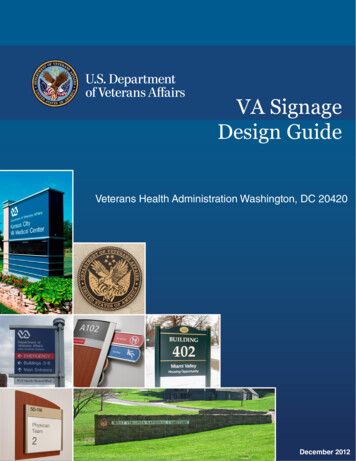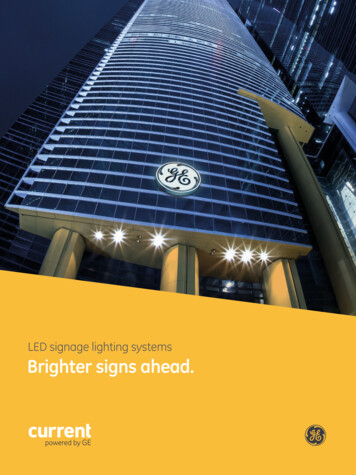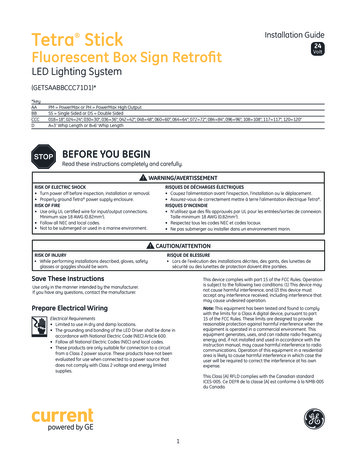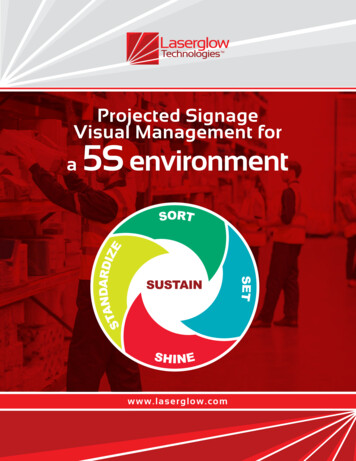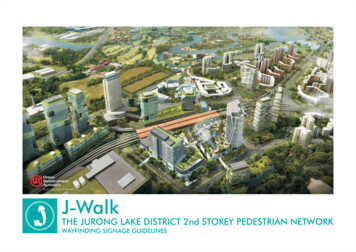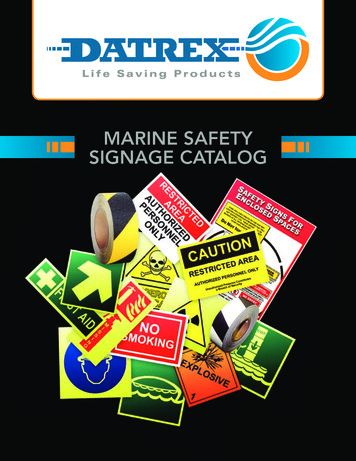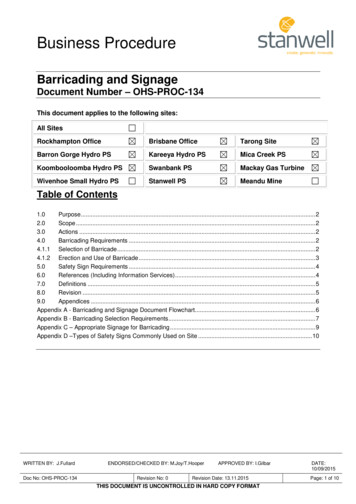
Transcription
Business ProcedureBarricading and SignageDocument Number – OHS-PROC-134This document applies to the following sites:All SitesRockhampton OfficeBrisbane OfficeTarong SiteBarron Gorge Hydro PSKareeya Hydro PSMica Creek PSKoombooloomba Hydro PSSwanbank PSMackay Gas TurbineWivenhoe Small Hydro PSStanwell PSMeandu MineTable of Contents1.0Purpose . 22.0Scope . 23.0Actions . 24.0Barricading Requirements . 24.1.1 Selection of Barricade . 24.1.2 Erection and Use of Barricade . 35.0Safety Sign Requirements . 46.0References (Including Information Services) . 47.0Definitions . 58.0Revision . 59.0Appendices . 6Appendix A - Barricading and Signage Document Flowchart. 6Appendix B - Barricading Selection Requirements . 7Appendix C – Appropriate Signage for Barricading . 9Appendix D –Types of Safety Signs Commonly Used on Site . 10WRITTEN BY: J.FullardDoc No: OHS-PROC-134ENDORSED/CHECKED BY: M.Joy/T.HooperRevision No: 0APPROVED BY: I.GilbarRevision Date: 13.11.2015THIS DOCUMENT IS UNCONTROLLED IN HARD COPY FORMATDATE:10/09/2015Page: 1 of 10
1.0 PurposeThis Business Procedure describes Stanwell’s minimum mandatory requirements for the selection and useof barricading and signage.2.0 ScopeThis Business Procedure applies throughout Stanwell, all its sites and all activities under Stanwell’scontrol. It applies to all Stanwell employees and contractors, including visitors to Stanwell workplaces.This Business Procedure does not apply to permanent edge protection installations, for example, handrailsand guarding.3.0 ActionsBarricading and signage shall only be used: when there are no other practical control measures available; as an interim measure until a more effective way of controlling the risk can be used or the hazardis no longer present; and to supplement higher level control measures or as a secondary control measure.It shall be ensured that barricading and signage is visible and legible to all concerned. Illumination ofbarricades and signs should be considered where general lighting, either natural or artificial, does notprovide suitable visibility.It shall be ensured that: processes are in place to instruct workers not to enter barricaded areas unless authorized to doso; barricading and signage is reviewed periodically to make sure it remains effective in controlling therisk; and barricades and signage that are no longer required are removed as soon as practicable.4.0 Barricading RequirementsBarricading controls shall be implemented and authorised as part of the safe work system to protectpersons from hazards such as: being struck by falling objects; being struck by moving plant; fall from height, including falling into open excavations, penetrations, and falls from unprotectededges such as removed flooring, walkways, stairs and / or hand railings. exposure to hazardous chemicals; unauthorised entry into a confined space or work area; and any potentially hazardous work processes, for example, hot works, scaffolding, radiation work andwork involving asbestos.Barricading controls shall also be implemented and authorised as part of the incident management andemergency response procedures.4.1 Selection of BarricadeWhen selecting the type of barricade (soft or hard), the following factors are to be considered as part of arisk assessment: risk associated with the hazard; visibility of the hazard; required strength of the barrier, for example, impact potential; andDoc No: OHS-PROC-134Rev: 0Rev Date: 13.11.2015THIS DOCUMENT IS UNCONTROLLED IN HARD COPY FORMATPage 2 of 10
the amount of clearance provided from the hazard by the barricade.In addition it shall be ensured that hard/solid barricading is used for: a fall from height risk greater than two metres; and excavations greater than 1.5 metres deep.It shall be ensured that barricading is designed, installed and used in accordance with the relevantAustralian Standards and Appendix B- Barricading Selection Requirements:Note: Where a risk assessment determines that a safety barrier system capable of physical protection isrequired, the barricade system shall be designed in accordance with the relevant Standard for theapplication of the barrier system: AS/NZS 4994.1:2009 Temporary edge protection – General requirements. AS/NZS 4994.3:2010 Temporary edge protection Part 3: Installation and dismantling for edgesother than roof edges. AS/NZS 3845:1999 Road safety barrier systems.4.2 Erection and Use of BarricadeThe barricade shall encompass the entire potentially affected area of the hazard and take into accountfactors such as: possible deflection of an object if it falls; slag or sparks created from hot work activities; distance from the hazard; and creating an additional hazard, for example, access and egress. Sites shall make sure thatbarricades are erected so that all sides of the hazard are protected from unauthorised access.All barricades shall be accompanied by an appropriate sign, which is to be placed on all access points.Refer to Appendix C – Appropriate Signage for Barricading. Signage is linked to the Safe Work Systemused on site, therefore signage may differ across sites. Signage will be standardised across sites when theconsolidated Safe Work System is implemented.Signs or tags shall clearly display the following information: the name of the person in charge of the barricaded area; the hazards that are within the barricaded area; the date; and the contact details of the person in charge of the area.It shall be ensured that where soft barricading is used to provide a means of restricted access around apenetration or an unprotected edge, it is to be located at least two (2) metres from the outside of the edge.Where star pickets are used to support a barricade and are driven into the ground 150mm or more, sitesshall implement Business Procedure: Excavation and Penetration.Where barricading is erected around excavations, the requirements of Business Procedure: Excavationand Penetration shall be implemented.Barricading for Electrical WorkBarricades and labels must be used for electrical maintenance to identify to the working party the safeaccess area for the task. In addition, where an energised switchboard is located in the same room orbarricaded area it shall have its own barricading and label to identify the hazard.When identified in a risk assessment, an electrical work barricade shall be erected to prevent access toelectrical hazards. The barricade shall be erected using appropriate stands and tapes or expandable barricadingsystems, and where practical and appropriate, with an opening no greater than 2 metres. TheDoc No: OHS-PROC-134Rev: 0Rev Date: 13.11.2015THIS DOCUMENT IS UNCONTROLLED IN HARD COPY FORMATPage 3 of 10
entry size can be varied by the Safe Work Coordinator to suit the work location provided it doesnot introduce a hazard and the work area is clearly delineated. Restricted access signs are to be placed at appropriate spacing along the barricade. Switchboards under isolation shall have details of the isolation recorded on the restricted accesssigns.High Voltage Testing Barricades A high voltage testing barricade shall be erected around electrical equipment that is under test toprovide a minimum safe approach distance for untrained persons. The distance is as listed underthe Queensland Electrical Safety Regulation 2013 for testing voltage that is to be applied. Where testing is performed inside metal clad switchgear or similar enclosed spaces, barricading isnot required provided the testing area is not left unattended and a red flashing light is used whentest voltages are applied. Flashing red lights shall be installed and activated when test voltages are applied.5.0Safety Sign RequirementsIt shall be ensured that safety signs are erected to warn workers of specific hazards and to communicatenecessary precautionary measures and emergency actions.As a minimum, it shall be ensured that safety signs are erected in accordance with Queensland WorkHealth and Safety Regulation 2011, including, but not limited to: confined spaces; specific personal protective equipment (PPE) requirements; hazardous chemicals; asbestos; lead; fire protection equipment; hazardous areas; emergency and first aid information; emergency eyewash and shower; and traffic management and pedestrian control.Safety signs erected shall meet the requirements of the relevant legislative requirement and AustralianStandards (refer References).Refer to: Appendix D – Types of Safety Signs Commonly Used on Site.6.0References (Including Information Services)SourceReferenceLegislation Australian Standard Doc No: OHS-PROC-134Rev: 0Queensland Work Health and Safety Regulation 2011, s68, s305A,s308, s353, s469Queensland Electrical Safety Regulation 2013AS 1319:1994 Safety signs for the occupational environment.AS 4687:2007 Temporary fencing and hoardings.AS/NZS 4994.1:2009 Temporary edge protection – Generalrequirements.AS/NZS 4994.3:2010 Temporary edge protection Part 3:Installation and dismantling for edges other than roof edges.Rev Date: 13.11.2015THIS DOCUMENT IS UNCONTROLLED IN HARD COPY FORMATPage 4 of 10
SourceReference AS 1742.1:2014 Manual of uniform traffic control devices. Part 1:General introduction and index of signs.AS 1742.3:2009 Manual of uniform traffic control devices. Part 3:Traffic control for works on roads.AS/NZS 3845:1999 Road safety barrier systems.Business Procedures Excavation and Penetration OHS–PROC-126Stay Safe Barricading and Signage OHS-PROC-134ATools Nil 7.0DefinitionsTermMeaningBarricadeMeans a physical barrier, usually temporary, erected or placed torestrict the entry of persons to an area and/or prevent personnel beingexposed to a hazard.Barricades can be classed as either a soft barricade or a hard (solid)barricade.Soft barricades are those that use an approved tape to prevent orrestrict access to an area. They are suitable in situations wherephysical protection by use of a safety barrier system is not warranted.A hard barricade is a self-supporting fence, or a self-supporting seriesof continuous plastic, concrete or other solid barriers, erected or placedto restrict the entry of persons to an area. Examples include scaffoldtubes, concertina/expandable barriers, and water filled plastic orconcrete modular devices (Jersey type barriers).Note: Hard barricades can provide a safety barrier system capable ofphysical protection of workers e.g. from the impact of an out-of-controlvehicle / mobile plant, or preventing a person from falling off / into anunprotected edge / surface penetration. Where a risk assessmentdetermines that physical protection from a hazard is required, thebarricade system shall be designed in accordance with relevantAustralian Standards.Safe Work CoordinatorCoordinator of the work party/work activity associated with the safework authorisation.Note: Until the consolidation of Safe Work Systems across sites isimplemented this is equivalent to the Officer in Charge or Authority toWork Coordinator.SignAn inscribed board, plaque or other delineated space on which acombination of legend or symbolic shape is used to convey amessage.8.0 RevisionRev.No.0Rev.Date13.11.2015Doc No: OHS-PROC-134Revision DescriptionDocument created to consolidateexisting documents for Barricadeseg, OHS-PROC-113Rev: 0Written byJ. FullardEndorse/CheckM.Joy/T.HooperRev Date: 13.11.2015THIS DOCUMENT IS UNCONTROLLED IN HARD COPY FORMATApproved byIan GilbarPage 5 of 10
9.0 AppendicesAppendix A - Barricading and Signage Document FlowchartDoc No: OHS-PROC-134Rev: 0Rev Date: 13.11.2015THIS DOCUMENT IS UNCONTROLLED IN HARD COPY FORMATPage 6 of 10
Appendix B - Barricading Selection RequirementsTypeAccess Conditions & ApplicationCautionAccess permitted, caution required.ExamplesbarricadesoftypesThe caution tape is to be used to highlighthazards to other personnel that may need toaccess the area. Any person may access intoa caution barricaded area, as long as theyhave familiarised themselves with the hazardsdetailed on the barricade signage andimplemented any controls indicated on thesignage. This tape is not appropriate formedium, high or extreme risk hazards e.g.unprotected edges, falling objects, dAccessElectrical Work/Access permitted under instruction andauthority given from the Safe
unauthorised entry into a confined space or work area; and any potentially hazardous work processes, for example, hot works, scaffolding, radiation work and work involving asbestos. Barricading controls shall also be implemented and authorised as part of the incident management and emergency response procedures. 4.1 Selection of Barricade When selecting the type of barricade (soft or .



